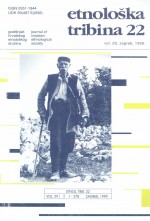Miraz
Dowry
Author(s): Snježana KlopotanContributor(s): Snježana Ivanović (Translator)
Subject(s): Gender Studies, Customs / Folklore, Cultural Anthropology / Ethnology
Published by: Hrvatsko etnološko društvo
Keywords: wedding customs; dowry; Lika;
Summary/Abstract: Field research in Gacka Valley and Pazarišta has confirmed the great importance of dowry in the agreements on contracting a marriage, as well as the differentiation of particular parts of dowry by using different terms that mark its every part. First, the equipment that bride brings into marriage is separated from the rest of the dowry, which in Pazarišta was often not marked by just one term, but the differentiation was made also within that part of the dowry with regard to its contents. Certain specific terms for all these parts of the dowry appear, whose meaning differs from village to village in that area. Besides characteristic terms miraz and prćija specific terms such as nametak and imetak also appear. Data collected in the field are the starting point for the research of this topic in the whole area of Lika. By means of the data analysis the author found out that the differentiation of dota (meaning bride’s equipment) from the rest of the dowry, which is marked by a range of variants, is characteristic for Lika. The author has paid special attention in the article to other aspects of the dowry as well: agreement on and disposal of the dowry, while a detailed review of characteristic customs related to the bride’s equipment forms a separate whole which points out to numerous variants of these customs within the narrower area. Other variations, such as differences in the day of transporting the dota, in persons who arrange it in bridegroom’s house, etc., could represent the possibility of the simultaneous existence of several variants in the same area. The contents of the dowry could also vary from village to village, depending on the current economic and social-political circumstances, as well as the customs related to search, transport and making of particular parts of the dowry. In the period between the two world wars, in the conditions of dissolution of the communal household organisation of family life, many changes occurred in the customs concerning the dowry. In war conditions the content of the dowry changed and was reduced to a certain extent and it was gradually adjusting to the individual property conditions of the family. The author particularly stresses certain differences related to the phenomenon of dowry and customs in the area of Pazarišta and Gacka Valley, and tries to identify their causes within their different geographical position and the impact of economic and social factors. The author concludes that cultural heritage of Lika to a great extent influenced the content of the dowry and the customs related to search, transport and making of some of the parts of the equipment. It also influenced the changes that occurred with time, as well as the regional differences between these two parts of Lika. The population of Gacka Valley consists mainly of indigenous Croats, in Pazarišta they are Croats Bunjevci, who came to this area in the 17th century, having passed through Velebit, as well as Serb immigrants in the 16th and 17th centuries, during the rule of Turks. Judging by the many details about dowry, Pazarišta gravitate towards the southeastern part of Lika, which is also settled by Bunjevci and Serbs. It is especially visible in the related procedures regarding the repurchase of the chest and in the representation of the term prdija. Comparison with the documents on dowry in other areas of Lika has shown that in the whole area of Lika bride’s equipment (dota, ruho, nivo, etc.) is separated from the rest of the dowry (land, cattle, money...). Only in Pazarišta, as a narrow regional specificity, this part of the dowry as well is marked by various terms related to its content. The specificity of Pazarišta is also the consecrating of the chest before transport, and sprinkling of grain. Field research in the Gacka Valley and in Pazarišta have primarily pointed to these specific phenomena, as well as on a range of similarities with other areas of Lika in understanding of the dowry, which can be a stimulus for more detailed research.
Journal: Etnološka tribina : Godišnjak Hrvatskog etnološkog društva
- Issue Year: 29/1999
- Issue No: 22
- Page Range: 85-105
- Page Count: 21
- Language: Croatian

